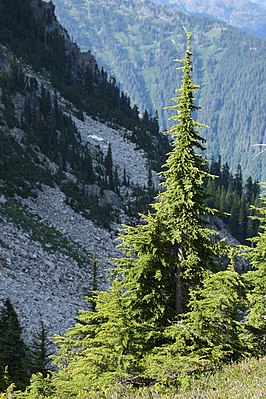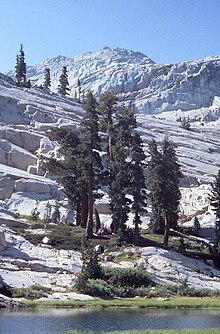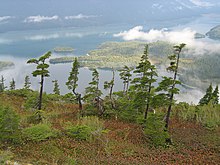Mountain hemlock
| Mountain hemlock | ||||||||||||
|---|---|---|---|---|---|---|---|---|---|---|---|---|

Mountain hemlock ( Tsuga mertensiana ) |
||||||||||||
| Systematics | ||||||||||||
|
||||||||||||
| Scientific name | ||||||||||||
| Tsuga mertensiana | ||||||||||||
| ( Bong. ) Carriere |
The Mountain hemlock ( Tsuga mertensiana ) is a plant from the genus of hemlock ( Tsuga ) within the family of the Pinaceae (Pinaceae). The distribution area of the conifer extends along the south coast of Alaska and the west coast of Canada and the USA over a length of 4000 kilometers. It grows in the snowiest areas of North America and gets by with extremely short growing seasons . It is of little economic importance and is only rarely used as an ornamental wood.
description
Vegetative characteristics
The mountain hemlock is a slowly growing, evergreen tree that reaches heights of 10 to 30, rarely up to 46 meters. The maximum diameter at chest height is 150 centimeters. The crown is narrow and conical, the branches are thin and overhanging. In Alaska and the Sierra Nevada it remains small near the tree line and also takes on shrubby forms. Very old free-standing trees have irregular, large-branched and often crooked crowns.
The 2.5 to 3.8 centimeters thick bark of older trees is dark, gray-brown, deeply furrowed and hard. Young trees have a light gray to gray and smooth bark. The wood is dense and has an almost white sapwood and a red to light brown core . The root system is shallow and extensive.
The young twigs have a reddish brown bark that is hairy for the first two to three years . The winter buds reach a length of up to 5 millimeters. They are pointed-ovoid and have reddish-brown, sub-rather pointed bud scales. Thereby flower buds and leaf buds differ. The female flower buds on a branch are about 3 millimeters longer than the leaf buds; both are covered by 25 bud scales. The outer scales are lighter and hairy, the inner ones are glossy dark brown. The male flower buds are about 2 millimeters long and have ten bud scales, the outer ones being light brown and somewhat thickened and the inner ones being thinner and white.
The needles are close and, in contrast to other hemlocks, arranged radially on the branches, whereby they are a little closer at the top. They are 0.5 to 2.5 inches long and 1 to 1.2 millimeters wide. The needles are linear , blunt and have entire margins and are blue-green to silver-white in color. They end at the base with a slender stem. The top is curved and the front part has stomata strips on both sides . The needles of the mountain hemlock remain on the tree for about three to four years.
Generative characteristics
Like all hemlocks, the mountain hemlock is single-sexed ( monoecious ) and can be mated at around 20 years of age . The female cones are in the upper third, the male in the lower part of the crown. The female cones stand upright at the ends of young twigs and have shiny purple-red, more rarely yellow-green seed scales. The deck scales are not visible. The male cones stand on the side of the branches in the axils of last year's needles and are purple to purple in color. The pollen has two air sacs, which distinguishes it from the pollen of other Tsuga species. After pollination, the empty male cones remain on the tree for several months. The flowering period begins in June, in northern locations not until July. Pollination takes place around the beginning of August. The trees bloom annually. Every two to eight years they bloom and produce particularly strong fruit ( mast years ), and less often on wet ground.
The growing cones are reddish to purple-red and turn brown when ripe in mid-September. They then have a length of 3 to 8 centimeters, are oblong-cylindrical and taper on both sides. They consist of 80 to 100 fan-shaped scales, each with two ovules. The edge of the scales is thin, unevenly toothed or somewhat frayed. The outermost scales on the tip of the cone and the base of the cone usually do not form seeds. Usually about 70 seeds are formed per cone, of which about 30 are whole grains. They are released from the cones from the middle of October, as the scales bend back, which then close again when it is wet. Empty cones can remain on the tree for another year. The seeds are 3 millimeters long, light brown and have a rectangular wing about 8 millimeters in size. They are spread by the wind and sprout epigeously .
The number of chromosomes is like all hemlock 2n = 24th
ecology
Storms cause damage because of the shallow root system and fires because of the low-hanging branches. However, newly grown stands after fires usually reach a very high trunk density of 10,000 to 25,000 trunks per hectare.
pathology

The mountain hemlock is rarely attacked by insect pests, more damaging are root and stem rot pathogens. Among them, the pore sponge Phellinidium weirii leads to major failures, with entire forest areas being affected. In the cascade chain, this led to the death of trees on areas of up to 40 hectares. The regrowing young trees remain largely unaffected. Damage is also caused by the root sponge ( Heterobasidion annosum ), the spruce spruce ( Fomitopsis pinicola ), Phellinus pinii and Phaeolus schweinitzii . It is more rarely attacked by Echinodontium tinctorium .
The dwarf mistletoe Arceuthobium tsugense subsp. mertensianae leads to the formation of witch brooms , bushy adhesions in the treetop. This species is also found as a parasite on the purple fir ( Abies amabilis ), the rocky mountain fir ( Abies lasiocarpa ) and the noble fir ( Abies procera ), but it is absent on the West American hemlock ( Tsuga heterophylla ).


Distribution, location requirements and endangerment
The natural range of the mountain hemlock extends from southern Alaska via British Columbia (Canada) and the northwest of the USA to California , Idaho and Montana over a length of about 4,000 kilometers. The southern limit of their range is in Sequoia National Park in the southern Sierra Nevada of California. It often grows in sub-alpine altitudes of the Coast Mountains , the Cascade Range and the Siskiyou Mountains . There are also particularly rich closed stocks in Crater Lake National Park . Their habitat ranges from the coast of Alaska to altitudes of 3000 meters in the Sierra Nevada. In Canada they are found at altitudes between 750 and 1800 meters.
The mountain hemlock thrives in cool to cold maritime climates with mild to cold winters and warm to cool summers. It inhabits the snowiest areas in North America, often forms the tree line and manages with very short vegetation periods. The frost-free time in the Sierra Nevada is only about 50 to 60 days. The air temperature in the range varies in the annual mean between 3 and 4 ° C, the mean temperature in January between -7 ° C in Alaska and -3 ° C in British Columbia. The mean July temperature is between 11 and 13 ° C. The amounts of precipitation are more scattered and are between around 1000 and 3000 millimeters per year. The snow cover can stay there until August and reach a height of 7.5 meters. Most of the time, the snow in the distribution area is heavy and wet and can push young trees to the ground for months without causing failures.
The mountain hemlock grows on soils of volcanic and glacial origin, on metamorphic rocks and on sandstone . Calcareous soils are avoided. Loose, coarse-grained, well-drained, fresh soils are ideal. The pH of the soil ranges from 3.4 to 6.2. In Alaska and British Columbia it is also found on the edge of moors, where it remains short and crooked. It often grows on bare rock in the coastal mountains and in the Sierra Nevada.
They are mostly found in mixed stands, pure stands are found in Alaska and in the Cascade Range. In deeper areas they are found together with the Western White Pine ( Pinus monticola ) and the magnificent fir ( Abies magnifica ), at higher altitudes with the lodgepole pine ( Pinus contorta ) and the White-Russians pine ( Pinus albicaulis ), Canada also with the Engelmann spruce ( Picea engelmannii ), the rocky mountain larch ( Larix lyallii ), the rocky mountain fir ( Abies lasiocarpa ) and the purple fir ( Abies amabilis ).
In the Red List of IUCN the mountain hemlock will be deemed not at risk ( "Lower Risk / least concern"). It is pointed out, however, that a new check of the risk is necessary.
Systematics
The mountain hemlock ( Tsuga mertensiana ) is a species from the genus of the hemlock ( Tsuga ). There it is the only species of the subgenus Hesperopeuce . It differs from the other species of the genus Tsuga and subfamily Abietoideae in several features :
- It forms stomata on both the upper and lower side of the needles, similar to the firs ( Abies ), cedars ( Cedrus ), Keteleeria and Nothotsuga longibracteata . In other hemlocks, they are only on the underside.
- The seed cones stand upright during pollination as in the firs ( Abies ), cedars ( Cedrus ), Keteleeria and the golden larch ( Pseudolarix ). In other hemlocks, the seed cones hang.
- The pollen has two air sacs like most representatives of the pine family (Pinaceae), the other hemlocks only one like only larches ( Larix ) and Nothotsuga longibracteata .
- The pollination mechanism is similar to that of firs ( Abies ) and cedars ( Cedrus ) and differs from that of other hemlocks.
It is therefore assigned to its own subgenus Hesperopeuce , the other hemlocks to the subgenus Tsuga . Some authors also classify it as Hesperopeuce mertensiana (Bong.) Rydb. to the monotypical genus Hesperopeuce , it is not counted among the hemlocks. Due to the different characteristics, it was also considered that the mountain hemlock is a hybrid between the West American hemlock ( Tsuga heterophylla ) and the Sitka spruce ( Picea sitchensis ), which was referred to as Tsuga × jeffreyi (Henry) Henry . Apparent intermediate forms between Tsuga heterophylla and Tsuga mertensiana , which were found in the overlap area of the two species, spoke in favor of this. However, more detailed studies have shown that these forms are mostly representatives of Tsuga heterophylla that have adapted to the extreme snow conditions. A hybrid status cannot be derived from the investigations. Attempts to cross the two species artificially were also unsuccessful.
Phylogenetic studies of the nucleic acids of the cell nucleus and the chloroplasts show, however, that the mountain hemlock is a sister species of the West American hemlock ( Tsuga heterophylla ), and that these two form a sister group to the other hemlocks. From the classification in a separate subgenus one would expect that the mountain hemlock is a sister species to all other hemlocks.
The following subspecies and varieties are distinguished:
- Tsuga mertensiana subsp. mertensiana var. mertensiana : The seed cones have a length of 3 to 5.5 centimeters, rarely only 2 or up to 6 centimeters. 50 to 72 dark brown seed scales are formed that are 10 to 13 millimeters long and 7 to 10 millimeters wide.
- Tsuga mertensiana subsp. mertensiana var. jeffreyi (A. Henry) CKSchneid. The needles are more or less comb-shaped, and the short shoots cannot be distinguished from the long shoots. The seed cones are similar to those of the mertensiana variety . The variety was described by finds from Vancouver Island , but could not be found in 2005 either on the island or on the nearby mainland.
- Tsuga mertensiana subsp. grandicona Farjon : The seed cones are larger than those of the subspecies mertensiana with a length of 3.5 to 8.1 centimeters and a diameter of 1.9 to 3.3 centimeters. 40 to 52 light brown seed scales are formed that are 12 to 18, a maximum of 20 millimeters long and 10 to 15 millimeters wide. The distribution area is in California in the Siskiyou Mountains and in the Sierra Nevada and possibly also in southern Oregon.
Research history
The mountain hemlock was found by the German biologist Karl Heinrich Mertens (1796-1830) near Sitka in Alaska. The collection of Mertens was the German botanist Gustav Heinrich von Bongard in St. Petersburg evaluated, the this kind in 1832 as Pinus mertensiana ( Basionym ) in the journal Memoires de l'Academie Imperiale des Sciences de St.-Petersbourg firstdescribed has. The French gardener and botanist Élie-Abel Carrière placed them in the second edition of his Traite General des Coniferes in 1867 as Tsuga mertensiana in the genus of the hemlocks ( Tsuga ). Another synonym for Tsuga mertensiana (Bong.) Carriere is Tsuga pattoniana (J.Jeffrey ex Balf.) Engelm.
The scientific generic name Tsuga chosen by Carrière comes from the Japanese and refers to the southern Japanese hemlock ( Tsuga Sieboldii ). The specific epithet mertensiana honors the finder Karl Heinrich Mertens .
use
The mountain hemlock is of little economic importance, which can also be attributed to the usually inaccessible locations. However, attempts at cultivation in Central Europe have failed. It is of little importance for erosion protection.
The wood is mostly used together with the wood of the West American hemlock ( Tsuga heterophylla ) as plywood , construction wood for interior construction and for the production of pulp and paper.
It is seldom used as an ornamental wood ; in Europe it is usually only found in collections. The cultivar 'Glauca' is used more often as an ornamental plant, which differs from the wild form in that it grows more slowly and has blue-green and blue-white frosted needles.
proof
literature
- Peter Schütt, Horst Weisgerber, Hans J. Schuck, Ulla Lang, Bernd Stimm, Andreas Roloff: Lexicon of Conifers. Distribution - Description - Ecology - Use; the great encyclopedia . Nikol, Hamburg 2004, ISBN 3-933203-80-5 , p. 627-634 .
- Aljos Farjon: A Handbook of the World's Conifers . tape 2 . Brill, Leiden-Boston 2010, ISBN 978-90-04-17718-5 , pp. 1017-1018 .
- Andreas Roloff , Andreas Bärtels: Flora of the woods. Purpose, properties and use. With a winter key from Bernd Schulz. 3rd, corrected edition. Eugen Ulmer, Stuttgart (Hohenheim) 2008, ISBN 978-3-8001-5614-6 , p. 793.
- Steve Cafferty: Cosmos Atlas Trees of the World . Franckh-Kosmos, Stuttgart 2008, ISBN 978-3-440-10983-0 , p. 62 .
- Russell H. Burns: Silvics of North America . Conifers. In: Agriculture Handbook . tape 654 . United States Government Printing, Oxford 1991, ISBN 0-16-027145-2 ( online ).
Individual evidence
- ↑ a b c d Roloff et al .: Flora der Gehölze , p. 793
- ↑ a b c d e f Schütt et al .: Lexicon of Conifers , p. 629
- ↑ a b c d e Schütt et al .: Lexicon of Conifers , p. 631
- ↑ a b c Schütt et al .: Lexicon of Conifers , p. 630
- ↑ Tsuga mertensiana. In: Flora of North America Vol. 2. www.eFloras.org, accessed on March 26, 2011 (English).
- ↑ a b c Schütt et al .: Lexicon of Conifers, pp. 632–633
- ↑ a b Schütt et al .: Lexicon of Conifers , p. 632
- ↑ Tsuga mertensiana in the endangered Red List species the IUCN 2010. Posted by: Conifer Specialist Group, 1998. Accessed March 28, 2011th
- ↑ Christopher J. Earle: Tsuga. In: The Gymnosperm Database. Retrieved March 27, 2011 .
- ^ A b Nathan P. Havill, Christopher S. Campbell, Thomas F. Vining, Ben LePage, Randall J. Bayer, Michael J. Donoghue: Phylogeny and Biogeography of Tsuga (Pinaceae) Inferred from Nuclear Ribosomal ITS and Chloroplast DNA Sequence Data . In: American Society of Plant Taxonomists (Ed.): Systematic Botany . tape 33 (3) , 2008, pp. 478-489 .
- ^ A b Tsuga mertensiana in the Germplasm Resources Information Network (GRIN), USDA , ARS , National Genetic Resources Program. National Germplasm Resources Laboratory, Beltsville, Maryland. Retrieved March 26, 2011.
- ↑ Cafferty: Kosmos-Atlas Trees of the World , p. 61
- ^ Burns: Silvics of North America Conifers
- ^ Farjon: A Handbook of the World's Conifers , p. 1018
- ^ A b Harry A. Alden: Softwoods of North America . US Department of Agriculture, Forest Service, Madison WI 1997, p. 129–130 ( Online [PDF; 710 kB ]).
- ^ Farjon: A Handbook of the World's Conifers , p. 1017
- ↑ Helmut Genaust: Etymological dictionary of botanical plant names. 3rd, completely revised and expanded edition. Nikol, Hamburg 2005, ISBN 3-937872-16-7 , p. 661 (reprint from 1996).
- ↑ Schütt et al .: Lexicon of Conifers , p. 628
- ↑ a b Schütt et al .: Lexicon of Conifers , p. 633
Web links
- Tsuga mertensiana at Plants For A Future . Retrieved April 16, 2011.
- Tsuga mertensiana. In: Plants Database. United States Department of Agriculture, accessed April 16, 2011 .
- Thomas Meyer: Data sheet with identification key and photos at Flora-de: Flora von Deutschland (old name of the website: Flowers in Swabia ).






